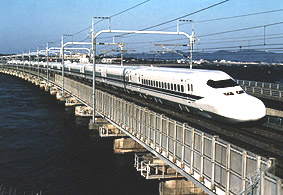|
MONTHLY NEWS April 1999 Bullet Trains of the Future Enter Service |
 A new type of Nozomi Shinkansen (bullet
train) made its debut on the Tokaido and Sanyo routes on March 13, amusing
passengers with its distinctive, beak-like look. The start of service was
marked with a ceremony on the platform of Tokyo Station.
A new type of Nozomi Shinkansen (bullet
train) made its debut on the Tokaido and Sanyo routes on March 13, amusing
passengers with its distinctive, beak-like look. The start of service was
marked with a ceremony on the platform of Tokyo Station.
One schoolchild who was invited to the event, 8-year-old Nozomi Nishimura of Edogawa Ward, Tokyo, said, "I thought that the new train, which has the same name as me, looked cool. I want to ride it to Osaka to go see my kindergarten teacher, who moved there after she got married." The new 700-series bullet trains were developed jointly by the Central Japan Railway Company (JR Tokai), which operates the Tokaido route, and the West Japan Railway Company (JR West), which runs the Sanyo segment. The newest model will make three round-trips between Tokyo and Hakata every day. It has a maximum operating speed of 285 kilometers per hour, which is actually 15 kph slower than the 500-series Nozomi trains, which are among the fastest in the world. Travel time between Tokyo and Hakata for the 700 series is 4 hours 57 minutes, which is actually 8 minutes longer than for the 500 series. The reason the 700 series is slower, JR officials said, is because it emphasizes energy conservation and noise reduction rather than sheer speed. Noise from air resistance has long been a big problem for bullet trains, especially when they enter tunnels. The solution designers came up with was to shape the front and rear cars like the bill of a duck. To carry passengers in greater comfort, moreover, the new train use a new type of semiconductor that makes the sound of the motors less audible to human ears. The ceiling is also higher by as much as 6.5 centimeters, and passageways have been widened. All the pay phones on the new model train are in boxes so that callers can hear the calls better. There are also vending machines selling drinks and snacks. A vacuum system is used to flush toilets, just like on airplanes. Despite the sleek design, the 700 series has a seating capacity as high as previous bullet train--an improvement from the 500 series, which sat fewer passengers in the first and last cars because of its extra long nose. Another shortcoming of the 500 series, the fact that it could't be linked up with cars of other series, has also been fixed in the newest trains. The original Shinkansen cars, or the 0 series, went into service in 1964, and production continued through 1986. The 300-series Nozomi cars with a maximum speed of 270 kph made their debut in 1992, cutting travel time between Tokyo and Osaka to two-and-a-half hours. The 500-series Nozomi was introduced in 1997.
Photo: The 700-series shinkansen shows its speed. (Central
Japan Railway Co.) |
.

|